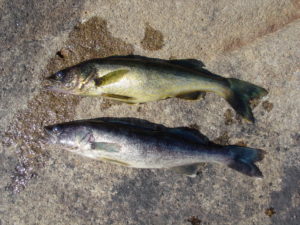Dr. Wayne Schaefer, Professor Emeritus of Biological Sciences at UW-Washington County (UW-WC) along with colleagues from UW-Sheboygan and the University of Iowa and the National Center for Biological Studies in Bangalore, India, recently announced, in the Proceedings of the National Academy of Sciences, that they had discovered a new fluorescent protein in walleye fish from northwestern Ontario, Canada.
The protein is blue in color and was first observed by Schaefer in blue colored walleye in the Papaonga River System near Ear Falls, Ontario, about 150 miles north of the US-Canadian border in 1992.
Schaefer, a fish biologist, started teaching at UW-WC in 1978. His primary area of research has been the biology of walleye in Ontario, Canada.
While collecting samples near his cabin in Ontario in 1992 he began catching walleye that were blue in color rather than the normal yellow color. He noted that the blue color was located in the skin mucus of the fish. He realized that no other fish species in the world was ever reported to have color in their mucus, only in their scales.
Schaefer initially hypothesized that the blue color was caused by a symbiotic micro-organism living in the mucus of the fish. Specimens were brought back to the campus and an extensive effort was made to identify a bacterium or algae living in the fish mucus. Hundreds of students from the West Bend High Schools aided in an effort to identify a potential micro-organism. High school students in both Paul De Chant’s AP biology classes and Bob Clingen’s AP chemistry classes worked evenings on the research in UW-WC labs for three years, before concluding that the color was not caused by a micro-organism.
In further efforts to determine the source of blue color, Schaefer took samples of blue mucus to Dr. David Gibson at the University of Iowa who had recently engineered a blue pigment to be used to dye blue jean pants. Gibson was an internationally acclaimed microbiologist who happened to love fishing.
He took on the project and quickly determined that the blue pigment was a new protein and was secreted by the skin of the fish and not by any micro-organism. The protein was named sandercyanin. Further the protein contained biliverdin, a small chemical caused by breakdown of heme in the blood. Walleye in Wisconsin and Minnesota did not have blue color in their mucus; only walleye in Canada. What factor in Canada, and not the U.S. was causing this breakdown of heme into biliverdin?
An answer was suggested by one of the high school students who hypothesized that the ozone hole over the North Pole may be related to the phenomenon. Ozone in the upper atmosphere protects the earth from harmful ultraviolet (UV) radiation. For the last 40 years, holes in the ozone layer over both the North and South Poles have been observed. The cause of ozone depletion is an air pollutant (chlorofluorocarbon, CFC) found in older aerosol sprays that destroys ozone, thereby allowing UV radiation to more fully penetrate the earth’s atmosphere over the Poles. UV radiation is known to cause the breakdown of heme into biliverdin. Perhaps sandercyanin acted as a sunscreen to protect walleye in northern latitudes from UV radiation. Schaefer published the hypothesis last year in the Canadian Journal of Fisheries and Aquatic Resources.
In June of 2008, while examining mucus from blue walleye under the microscope at the University of Iowa, Schaefer illuminated the mucus with UV light and observed bright red fluorescence coming from mucus cells containing sandercyanin. Interestingly, the red fluorescence did not fade with time exposure to UV light. Several fluorescent proteins had already been discovered by 2008 but none fluoresced in red, a color better suited to deep tissue studies, and all faded rapidly with exposure to light. Fluorescent proteins are extensively used in modern biotechnology to study molecular genetics. They function as chemical tags for DNA and for cells. A Nobel Prize was awarded to researchers from the University of California – San Diego who discovered Green Fluorescent Protein in jellyfish. Sandercyanin has several important benefits beyond any other fluorescent protein discovered to date.
Although David Gibson retired from the University of Iowa in 2006, one of his colleagues, Subramanian Ramaswamy (Rams), continued to study the chemistry of sandercyanin in India where he became the director of a large research facility called The National Center for Biological Studies. There Rams assigned graduate students to the project. They have been successful in cloning the gene for sandercyanin and transplanting it into bacteria that now produce blue color. The University of Wisconsin has patented the gene and is seeking to license the patent to biotechnology companies capable to getting the product into labs around the world where sandercyanin will be used in medical research.
Schaefer who retired this spring, taught thousands of UW-WC students over the years and also accompanied over 600 students to Canada to participate in his research. It is with a great deal of pride that UW-WC acknowledges its contribution to medical research and to the accomplishments of one of its own professors.
UW-Washington County is located at 400 University Drive in West Bend. Over 850 students attend the West Bend campus which provides a quality learning environment with small class sizes and dedicated, experienced faculty. For more information on the campus, visit www.washington.uwc.edu
Photos attached: Dr. Wayne Schaefer with blue walleye; blue and yellow walleye – comparison.










